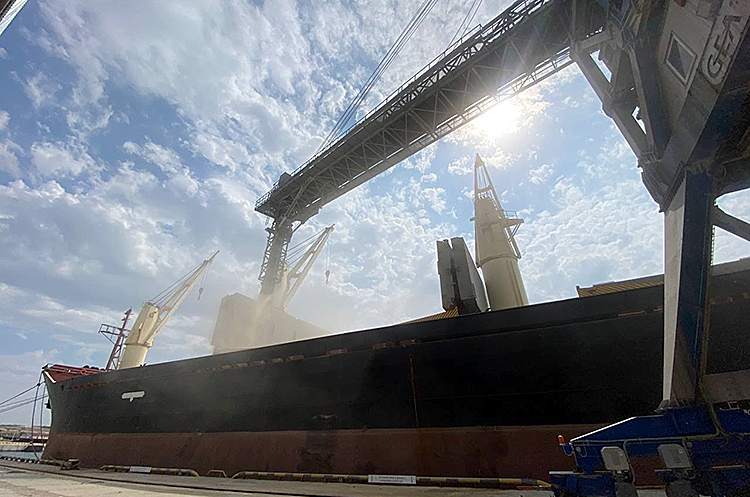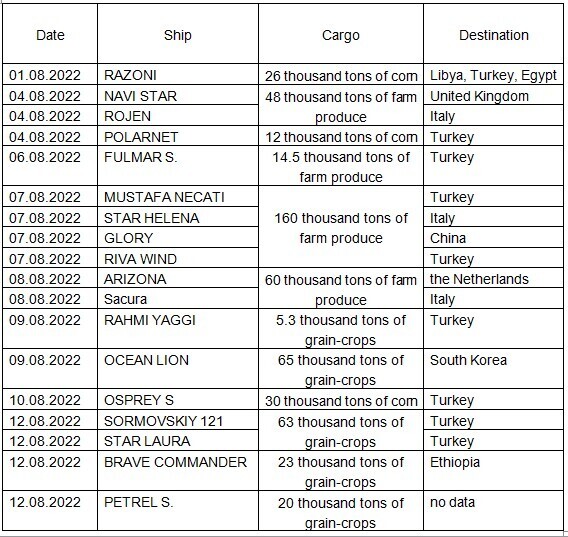Grain corridor: first results of resumed agro-export from Ukraine
The half month following the unblocking of the Ukraine ports has proved the viability of the Istanbul Treaty. Its main drawback is in its short period of validity.

Today, on August 15, is half a month after Ukraine restored its sea export, though on a limited scale. Access has been granted so far only to agrarian cargoes: the “humanitarian” component, not the commercial one, and references to the vital necessity of the Ukrainian grain for thousands of people around the world allowed reaching the agreement on the unblocking of ports. Although only one vessel, the Brave Commander, entered Odesa with a humanitarian mission during this time to load 23,000 tons of wheat for Ethiopia under the UN World Food Programme, we can state the main thing – the grain corridor works.
Is shipment increasing successfully?
During the half month, about 0.5 million tons of grain (370,000 tons during the first nine days) were shipped from Ukraine (not all ships have reached their destinations yet). The amount of shipment will exceed 1 million tons by the end of the month as the speed of export rises. The UN expects that in prospect this figure will increase by 2 to 5 times.
More realistic prognoses may be heard from the Ukrainian side: “We are moving gradually towards the intended ambitious plan – transshipping three and more million tons of food a month through Greater Odesa ports,” said Oleksiy Vostrikov, head of the Seaport Administration.
As of August 12, the Greater Odesa ports (Odesa, Chornomorsk, and “Pivdenny”) received (for arrival and departure) 18 vessels heading to seven countries of the world. Apart from pioneer RAZONI’s adventures, other voyages ended safely.
What troubles were on the way?
After the military threat in the Black Sea coast was conditionally eliminated, the primary commerce-hampering factors became economic. From the start, increased risk ratios have been applied to ships that enter Odessa ports. The official insurance premium that used to range from 3 to 5%, has risen to 5%.
Increased ship rent rates (freight) were also applied to Ukraine. The cost of freighting a ship with the biggest moving cargo load of 30,000 to 50,000 tons was rated 4-5 times higher for the first voyages to Odesa, than a similar voyage to the peaceful port of Constanta.
It was because the logistical and war risks made port tariffs far from fair that opening Odessa did not shake the attractiveness of transporting via land routes. Export transportation of grain cargoes in March–July 2022 increased almost by 2.2 times – from 0.42 million tons in March to around 0.91 million tons in July.
“Decreasing costs will have a positive influence on stabilising performance of the Ukrainian agrarian businesses,” noted Yuliya Svyrydenko, Ukraine’s Minister of Economy.
Will it be possible to increase export in the future?
Xclusiv Shipbrokers experts say that grain sea trade makes up 4% of the total amount of sea transportation; sea export of the Ukrainian grain was about 10% from the total sea export of grain in 2021. “Actual export (of the Ukrainian grain) will reach only 70%–80% of the 2021 level,” brokers think, and this will make up less than 0.3% of the total traffic by sea.
On July 22, Ukraine, Turkey, and the UN signed in Istanbul the “Initiative on the safe transportation of grain and foodstuff from Ukrainian sea ports” with the aim to partially unblock ports Odesa, Chornomorsk, and “Pivdenny” for exports of grain and fertilizers.
The terms of the Istanbul agreement are valid 120 days and have to be prolonged after this period, that is in late November. Given that the grain corridor runs conditionally efficiently, its significance grows and increases chances that russia is interested in reviewing the treaty in order to “force” additional preferences for itself.
According to the State Customs Service, from July 1, the beginning of 2022/23 the marketing year, to August 8, Ukraine exported 2 million tons of cereal and leguminous crops, including 387,000 in August. This is almost two times less than in the similar period last year when 3.87 million tons were exported, including 832,000 tons shipped in the same month.
The key export crop was wheat, 467,000 tons of which have been exported. Barley was in second place (180,000 tons). 1,343 tons of corn were shipped. The overall export of Ukrainian flour, as of August 8, was 4,800 tons (13,500 tons in the previous season), namely 4000 tons wheat flour (13,400 tons).
According to results of the first half of the year, the agri-foodstuff export in money terms was $10.11 billion, retaining its status as a key export grade with 44% share.
Representatives of other sectors, metallurgy most of all, are also likely to lobby for their right to use the sea corridor. Last year, exports of ore and metal earned $21.1 billion – this is the second most important item of Ukraine’s foreign trade, next to agrarian one. But such export would be hard to set out reasons for, as far as metallurgy cargoes are free from the humanitarian aura in contrast to foodstuffs.

Source: Seaport Administration of Ukraine, Ministry of Infrastructure, open sources.
If you have read this article to the end, we hope that means it was useful for you.
We work to ensure that our journalistic and analytical work is of high quality, and we strive to perform it as competently as possible. This also requires financial independence. Support us for only UAH 196 per month.
Become a Mind subscriber for just USD 5 per month and support the development of independent business journalism!
You can unsubscribe at any time in your LIQPAY account or by sending us an email: [email protected]


